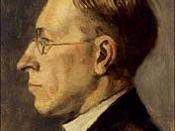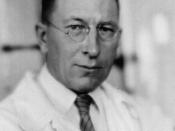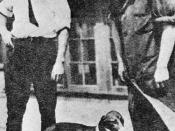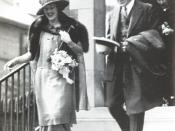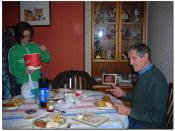While reminiscing about the 1920's, you cannot help but remember the one man who made that a defining decade in Canadian history, the co-discoverer of insulin, Sir Frederick Grant Banting. Banting was born on November 14th, 1891 in Alliston, Ontario to William Thompson Banting and Margaret Grant. He was the youngest of six children and was educated at the public and high schools at Allison. He was not the brightest kid in the class and dropped out of school at a young age to help with the family farm. He later went on to continue his education at Victoria College in the field of General Arts but failed and went on to University of Toronto to again try the arts. However, he soon switched to medicine and graduated in 1916. After graduating, he served in the Canadian Army Medical Corps in World War I where he was wounded but declined amputation and persisted upon helping people.
His bravery earned him a Military Cross. Banting wanted to be a surgeon and opened up a small clinic in London, Ontario. However, it was not as succesful as Banting envisioned and he only made $4. He was then offered a job teaching medicine at University of Western Ontario. On the night of October 31st, 1920, during his routine reading of articles of medical journals, Banting found something interesting in the journal, Surgery, Gynecology, and Obstetric. The article he read changed the way thought forever.
In the journal, Banting read a story on pancreas and he quickly recorded something in his journal. Fascinated by his idea, he left London for Toronto. He presented his idea of isolating an internal secretion of the pancreas to treat diabetes to the professor of physiology at University of Toronto, J.J.R. Macleod. Macleod allowed Banting to test his theories and presented him with a lab and an assistant, a young graduate student, Charles Best. There was no pay and the conditions were horrible but Banting was determined to find a cure for the disease. Banting and Best decided to test his theory on dogs first. At first, the results were disappointing but Banting was relentless. After many alterations to his initial theory, and countless dogs later, they were successfully able to stabilize diabetic dogs and were ready to try their method calves and cows. At this time, Macleod and a new helper, chemist James Bertram Collip began helping Banting and Best in their efforts. After months of research and experiments, the team was able to find a useful extract, named insulin. In 1922, a 14-year-old boy, Leonard Thompson, suffering from diabetes showed noticeable a recovery after becoming the first person to be treated with insulin. Numerous other patients who were previously presented with hopeless prognoses showed rapid improvement after being injected with the new drug.
Although Banting did not pursue the insulin discovery dream for fame and fortune, he certainly got a lot of it. In 1923, Banting and Macleod were nominated for and awarded the Nobel Prize in Physiology. Banting was unhappy with the omission of Best and shared his award money with him, as did Macleod with Collip. The four decided not to patent the serum, which cost them a fortune, but instead they sold its rights to U of T for $1 to confirm that no one could get profit from it. Banting was given many deserving honors in his lifetime to name them all would take forever. In 1922, Banting was appointed Senior Demonstrator in Medicine at the University of Toronto, and in 1923, he was elected to the Banting and Best Chair of Medical Research. He was also chosen as the Honorary Consulting Physician to the Toronto General Hospital, the Hospital for Sick Children, and the Toronto Western Hospital. For his research, the Canadian government gave him a lifetime grant and in 1934, King Georgy V knighted him. In 1994, Banting was inducted into the Canadian Medical Hall of Fame. In 2004, he was nominated as one of the top ten 'Greatest Canadians' as voted by CBC viewers and finished in fourth place. Banting also has many schools named after him, a medical hall in U of T, a crater, and countless books and websites dedicated to his life and accomplishments. Even all these awards and recognitions cannot compare to Banting's contributions to the world and to diabetic patients and their families.
Evidently, Banting was a selfless person and always thought about trying to make the world better. Besides his work on insulin, he gave valuable input and research on the adrenal glands, cancer, and silicosis. He was also the first to create a G-suit to help pilots cope with high-speed flying. This resulted in his selection in 1939 as the chairman of the National Research Council's Committee on Aviation Medical Research. Banting also served in World War II as a medic and while flying on a medical mission from Newfoundland to England on February 21st, 1941, Banting's plane crashed shortly after take-off. Even during his last breaths, he forgot about himself to save another human being as he saved the life of the pilot but he himself did not make it. Though Banting was only 49 when he died, he achieved more in his short life than most people can ever imagine doing and his legacy will certainly live on forever.
IMPACTFrederick Banting was a noble, selfless, and influential Canadian who by some is considered the greatest Canadian who ever lived for countless reasons. Banting is also believed to be the first Canadian scientist to achieve worldwide recognition and he was the first Canadian Nobel Prize Laureate. Frederick Banting is one of the most prominent, valuable, and respected people to ever come out of Canada. He contributed a lot to the Canadian society by participating in the war efforts. Banting aided many Canadian soldiers in both world wars even when he himself was injured. Although Banting did not make significant breakthroughs in other fields of his research, he certainly offered many valuable studies in various fields of medicine including cancer and silicosis. His research helped other scientists make important discoveries in those fields. Frederick Banting was also a very humble person who valued knowledge and generosity. This is clearly evident when his team gave the rights to insulin to University of Toronto so that no one could benefit from their discovery and to ensure that all profit would go towards further development of insulin and other medical advances. Ever since Banting and his team discovered insulin, millions of people have been able to live thanks to the serum. If not for Banting's idea that hallowe'en night, millions of people would not be alive today and the world would not have the works of many prominent people. Frederick Banting is truly an inspiration and the world will be forever appreciative to his discovery.
BIBLIOGRAPHYGarret, Alfred B. A Flash Of Genius. New Jersey: D. Van Nostrand, 1963. Page Number: 36Cruxton, J. Bradley, W. Douglas Wilson. Spotlight Canada. 4th ed. Canada: Oxford, 2000.
McClelland, Stewart. "Frederick Banting" The Canadian Encyclopedia. USA: The Canadian Publishers, 2000.
"Frederick Banting" The Greatest Canadian. Walsh. CBC. 2004.
The Canadian Encyclopedia. Banting, Sir Frederick. Bliss, Micheal. January 17, 2007.
.
"Banting, Sir Frederick Grant." Encyclopædia Britannica. 2007. Encyclopædia Britannica Online. January 17, 2007.
.
Wikipedia, The Free Encyclopedia. Banting, Frederick. January 17, 2007. .
Essortment. Banting and Best Biography. McGregor, Sharon. 2002. January 17, 2007.
.
The Nobel Foundation. Frederick G. Banting. January 17, 2007.
.
CBC. The Greatest Canadian, Frederick Banting. January 17, 2007.
.
Discovery of Insulin. Sir Frederick Grant Banting. January 17, 2007.
.
Answers. Frederick Banting. January 17, 2007.
.
